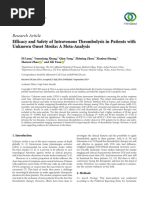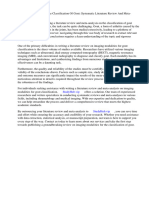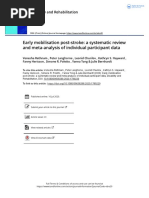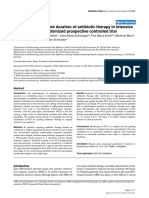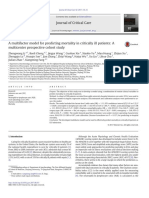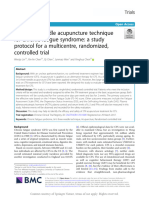Reduccion de Lactato en Shock Septico 2015
Reduccion de Lactato en Shock Septico 2015
Uploaded by
mayraCopyright:
Available Formats
Reduccion de Lactato en Shock Septico 2015
Reduccion de Lactato en Shock Septico 2015
Uploaded by
mayraOriginal Title
Copyright
Available Formats
Share this document
Did you find this document useful?
Is this content inappropriate?
Copyright:
Available Formats
Reduccion de Lactato en Shock Septico 2015
Reduccion de Lactato en Shock Septico 2015
Uploaded by
mayraCopyright:
Available Formats
Intensive Care Med (2015) 41:1862–1863
DOI 10.1007/s00134-015-3955-2 LETTER
Wan-Jie Gu the potential to be such a promising event proportion obtained from the
Zhongheng Zhang goal for quantitative resuscitation. results of the meta-analysis, and a
Jan Bakker We performed a meta-analysis of relative risk reduction of 20 % in
randomized controlled trials (RCTs) all-causes mortality, using standard
to evaluate the effect of early lactate software TSA version 0.9 Beta
clearance-guided therapy on mortality (http://www.ctu.dk/tsa).
Early lactate clearance-guided and other outcomes in patients with Four RCTs enrolling 547 patients
sepsis. were included in the meta-analysis
therapy in patients with sepsis: We searched PubMed, Embase, [2–5]. The main characteristics of the
a meta-analysis with trial and Cochrane Central Register of four included RCTs are presented in
sequential analysis Controlled Trials to identify RCTs Table 1 in the Electronic Supple-
of randomized controlled trials that evaluated the effect of early mentary Material (ESM). Assessment
lactate clearance-guided therapy on of the risk of bias is summarized in
Accepted: 8 June 2015 clinical outcomes in adults with Table 2 (ESM). Overall, two RCTs
Published online: 8 July 2015 sepsis. The search terms used were were categorized as at lower risk of
Ó Springer-Verlag Berlin Heidelberg and ‘‘lactate clearance’’, and ‘‘sepsis’’, or bias [2, 3], and two as at unclear risk
ESICM 2015 ‘‘severe sepsis’’ or ‘‘septic shock’’. of bias [4, 5]. Data on primary out-
W.-J. Gu and Z. Zhang contribute equally to We used the Cochrane collaboration come were provided in all four trials
the work. tool to assess risk of bias, and the (547 patients) [2–5]. Early lactate
GRADE (Grades of Recommenda- clearance-guided therapy was associ-
Electronic supplementary material tion, Assessment, Development and ated with a reduction in mortality (RR
The online version of this article
(doi:10.1007/s00134-015-3955-2) contains Evaluation) approach to evaluate the 0.65, 95 % CI 0.49–0.85, p = 0.002,
supplementary material, which is available quality of evidence. The primary I2 = 0 %, Fig. 1). TSA showed that
to authorized users. outcome was all-cause mortality. 34.5 % of the required information
Secondary outcomes included length size of 1586 patients were accrued.
of hospital stay and length of inten- The cumulative z curve crossed the
sive care unit (ICU) stay. We conventional boundary for benefit but
Dear Editor, calculated risk ratios (RRs) or mean did not cross the trial sequential
Sepsis represents a global problem differences (MDs) and 95 % confi- monitoring boundary for benefit,
with high economic burden for health dence intervals (CIs) using a random- showing that currently cumulative
care systems. Since 2002, the Sur- effects model. A two-tailed p value evidence is inconclusive, as shown in
viving Sepsis Campaign has less than 0.05 was considered a sig- Fig. 3 (ESM). For secondary out-
recommended early quantitative nificant level except for where a comes, early lactate clearance-guided
resuscitation for patients with severe certain p value has been given. All therapy had no effect on length of
sepsis and septic shock with a recent statistical analyses were performed hospital stay (weighted mean differ-
update [1]. However, the optimal using RevMan 5.2 (Nordic Cochrane ence, WMD –0.13 days, 95 %
goals for quantitative resuscitation Centre). We conducted trial sequen- CI –4.58 to 4.31, three RCTs [2, 3, 5])
remain uncertain. Lactate clearance, tial analysis (TSA) using a diversity- and length of ICU stay (WMD
defined by the change of lactate levels adjusted required information size –1.54 days, 95 % CI –3.22 to 0.15,
between two points in time, as a more calculated from an alpha error of four RCTs [2–5]), as shown in Fig. 2
rapid and less costly parameter, has 0.05, a beta error of 0.20, a control (ESM). The GRADE evidence
Fig. 1 Forest plot depicting mortality
1863
profiles for the primary and secondary 2. Jansen TC, van Bommel J, J. Bakker ())
outcomes are summarized in Table 3 Schoonderbeek FJ et al (2010) Early Department of Intensive Care Adults,
lactate-guided therapy in intensive care Erasmus MC University Medical Centre,
(ESM). The GRADE level of evi- unit patients: a multicenter, open-label, P.O. Box 2040, Room H625, 3000CA
dence was moderate for all-cause randomized controlled trial. Am J Respir Rotterdam, The Netherlands
mortality, and low for length of hos- Crit Care Med 182:752–761 e-mail: jan.bakker@erasmusmc.nl
pital stay and length of ICU stay. 3. Jones AE, Shapiro NI, Trzeciak S et al
(2010) Lactate clearance vs central
In summary, the use of lactate venous oxygen saturation as goals of J. Bakker
clearance as a goal to guide early early sepsis therapy: a randomized Department of Intensive Care, Pontificia
therapy is associated with a reduction clinical trial. JAMA 303:739–746 Universidad Católica de Chile, Santiago,
in the risk of death in adult patients 4. Tian HH, Han SS, Lv CJ et al (2012) The Chile
with sepsis. However, caution should effect of early goal lactate clearance rate
on the outcome of septic shock patients J. Bakker
be used to translate these findings to with severe pneumonia. Zhongguo Wei Division of Pulmonary and Critical Care,
clinical protocols, because data were Zhong Bing Ji Jiu Yi Xue 24:42–45 Columbia University College for Physicians
limited by insufficient information 5. Yu B, Tian HY, Hu ZJ et al (2013) and Surgeons/New York Presbyterian
size. Further, the underlying mecha- Comparison of the effect of fluid
resuscitation as guided either by lactate Hospital, New York, USA
nisms by which lactate clearance- clearance rate or by central venous
guided therapy benefits these patients oxygen saturation in patients with sepsis.
remain to be investigated. Zhonghua Wei Zhong Bing Ji Jiu Yi Xue
25:578–583
Compliance with Ethical Standards
Conflicts of interest The authors declare to W.-J. Gu
have no possible conflict of interest. Department of Anesthesiology, Affiliated
Drum Tower Hospital of Medical College
of Nanjing University, Nanjing, China
References Z. Zhang
Department of Critical Care Medicine,
1. Dellinger RP, Levy MM, Rhodes A et al Jinhua Municipal Central Hospital, Jinhua
(2013) Surviving Sepsis Campaign: Hospital of Zhejiang University, Jinhua,
international guidelines for management China
of severe sepsis and septic shock, 2012.
Intensive Care Med 39:165–228
You might also like
- Addiction Psychiatric MedicineDocument207 pagesAddiction Psychiatric MedicineDragutin Petrić100% (2)
- 2 Process Addresses Discharge of All Patients Including Medico-Legal Cases and Patients Leaving Against Medical Advice.Document6 pages2 Process Addresses Discharge of All Patients Including Medico-Legal Cases and Patients Leaving Against Medical Advice.Sanjay Kadam100% (1)
- Efficacy of Low-Level Laser Therapy in Carpal Tunnel Syndrome ManagementDocument10 pagesEfficacy of Low-Level Laser Therapy in Carpal Tunnel Syndrome ManagementChung Tze YangNo ratings yet
- Assignment 2 Teaching Plan NFDN 1002Document11 pagesAssignment 2 Teaching Plan NFDN 1002Donn AlegreNo ratings yet
- 100 Bedded General Hospital: Ground Floor PlanDocument1 page100 Bedded General Hospital: Ground Floor PlanAshish chauhan100% (3)
- National Fertility Clinic IncidentsDocument15 pagesNational Fertility Clinic IncidentsKaylyn ReneeNo ratings yet
- Journal of Critical CareDocument8 pagesJournal of Critical CareMuhammad HidayantoNo ratings yet
- Early Change in Platelet Count and MPV Levels of Patients Who Received Hemodialysis For The First Time Mogadishu Somalia ExperienceDocument5 pagesEarly Change in Platelet Count and MPV Levels of Patients Who Received Hemodialysis For The First Time Mogadishu Somalia ExperienceDea Fiesta JatikusumaNo ratings yet
- Early Change in Platelet Count and MPV Levels of Patients Who Received Hemodialysis for the First Time Mogadishu Somalia ExperienceDocument5 pagesEarly Change in Platelet Count and MPV Levels of Patients Who Received Hemodialysis for the First Time Mogadishu Somalia ExperienceDea Fiesta JatikusumaNo ratings yet
- 148415896sad2 - 73671 73671 IJP ApprovedDocument9 pages148415896sad2 - 73671 73671 IJP ApprovedIndra HedarNo ratings yet
- Jurnal BTKV DodiDocument10 pagesJurnal BTKV DodiAchmad Dodi MeidiantoNo ratings yet
- Hemodynamic Gain Index in WomenDocument5 pagesHemodynamic Gain Index in WomenERIK EDUARDO BRICEÑO GÓMEZNo ratings yet
- Carey 2005 CD4 Quantitation HIV + Child Antiretroviral TXDocument4 pagesCarey 2005 CD4 Quantitation HIV + Child Antiretroviral TXMaya RustamNo ratings yet
- Benefits and Risks of Tight Glucose Control in Critically Ill AdultsDocument12 pagesBenefits and Risks of Tight Glucose Control in Critically Ill AdultsCaio FeijóNo ratings yet
- GuiasddddDocument10 pagesGuiasddddKarla CastilloNo ratings yet
- Farez2011 PDFDocument10 pagesFarez2011 PDFAdindhya Saraswati SuryaNo ratings yet
- Sciencedirect: Original ResearchDocument8 pagesSciencedirect: Original ResearchThiamNo ratings yet
- Hao 2019Document45 pagesHao 2019carpe.diem.millieNo ratings yet
- Efficacy and Safety of Aspirin As An Adjunctive Therapy in TubercularDocument7 pagesEfficacy and Safety of Aspirin As An Adjunctive Therapy in TubercularYunita WidyaningsihNo ratings yet
- Atm 09 02 118Document10 pagesAtm 09 02 118idham shadiqNo ratings yet
- Luan2019 PDFDocument12 pagesLuan2019 PDFrifki irsyadNo ratings yet
- 10.1515 - Biol 2018 0050Document9 pages10.1515 - Biol 2018 0050alitrnfbNo ratings yet
- Correspondence: Cited or Read?Document1 pageCorrespondence: Cited or Read?AbdulAzizNo ratings yet
- 2017-Earlier Versus Later Initiation of Renal Replacement Therapy Among Critically Ill Patients With Acute Kidney Injury PDFDocument14 pages2017-Earlier Versus Later Initiation of Renal Replacement Therapy Among Critically Ill Patients With Acute Kidney Injury PDFClaudioLagosNo ratings yet
- Journal of Critical Care: Biao Wang, MD, Gang Chen, MD, Yifei Cao, MD, Jiping Xue, MD, Jia Li, MD, Yunfu Wu, MDDocument5 pagesJournal of Critical Care: Biao Wang, MD, Gang Chen, MD, Yifei Cao, MD, Jiping Xue, MD, Jia Li, MD, Yunfu Wu, MDpramastutiNo ratings yet
- Benefits of Esmolol in Adults With Sepsis and Septic Shock An UpdatedDocument13 pagesBenefits of Esmolol in Adults With Sepsis and Septic Shock An Updatedsergio salazarNo ratings yet
- 4Document6 pages4amenu4aie20024No ratings yet
- Extracorporeal Membrane Oxygenation (ECMO) Reconsidered: Point of ViewDocument5 pagesExtracorporeal Membrane Oxygenation (ECMO) Reconsidered: Point of ViewAnthonyHansenNo ratings yet
- Nihms 82233Document10 pagesNihms 82233LeonardoNo ratings yet
- Tight Glycemic Control in Critically Ill PediatricDocument11 pagesTight Glycemic Control in Critically Ill Pediatricbella friscaamaliaNo ratings yet
- Imaging Modalities For The Classification of Gout Systematic Literature Review and Meta-AnalysisDocument7 pagesImaging Modalities For The Classification of Gout Systematic Literature Review and Meta-Analysisea793wszNo ratings yet
- perner2015Document4 pagesperner2015dzulizzatjulaihiNo ratings yet
- Kontra Khanza 3Document10 pagesKontra Khanza 3LoserlikemeNo ratings yet
- Clinical Pharmacy Therapeu - 2020 - Wu - Loading Dose and Efficacy of Continuous or Extended Infusion of Beta LactamsDocument9 pagesClinical Pharmacy Therapeu - 2020 - Wu - Loading Dose and Efficacy of Continuous or Extended Infusion of Beta LactamsArturo ArturoNo ratings yet
- Lam 2018Document7 pagesLam 2018adrifen adriNo ratings yet
- 2009hetrase CCMDocument12 pages2009hetrase CCMgiseladelarosa2006No ratings yet
- Jurnal 5Document6 pagesJurnal 5Arswendo ValentinoNo ratings yet
- Artigo Mobilização PrecoceDocument9 pagesArtigo Mobilização PrecoceLuciana AlexandreNo ratings yet
- Effects of Risk Factors On Periodontal Disease Defined by Calibrated Community Periodontal Index and Loss of Attachment ScoresDocument23 pagesEffects of Risk Factors On Periodontal Disease Defined by Calibrated Community Periodontal Index and Loss of Attachment ScoresinkaNo ratings yet
- Predictive Biomarkers For Immunotherapy Response in Extensive Stage SCLCDocument11 pagesPredictive Biomarkers For Immunotherapy Response in Extensive Stage SCLCqjhojanjhesielNo ratings yet
- Glutamin Medi 94 E1319Document12 pagesGlutamin Medi 94 E1319Octavianus KevinNo ratings yet
- Tjtes 28 390Document5 pagesTjtes 28 390victor.evg1No ratings yet
- TENS - ArticleDocument10 pagesTENS - ArticleMickael LopesNo ratings yet
- 2-Statistical Controversies in Reporting of Clinical Trials - Part-2-Of-A-4 - 2015 - Journal-of-the-AmericaDocument15 pages2-Statistical Controversies in Reporting of Clinical Trials - Part-2-Of-A-4 - 2015 - Journal-of-the-AmericaPaulo SCNo ratings yet
- HY4 MSCJ DP XTDB C3 VF RM DVW BDocument9 pagesHY4 MSCJ DP XTDB C3 VF RM DVW BmarliivitorinoNo ratings yet
- Comparing The Efficacy and Safety of Apheresis and Whole Blood-Derived Platelet Transfusions - A Systematic ReviewDocument12 pagesComparing The Efficacy and Safety of Apheresis and Whole Blood-Derived Platelet Transfusions - A Systematic ReviewPritha BhuwapaksophonNo ratings yet
- s00134-019-05751-6Document13 pagess00134-019-05751-6Andres Andrade ErasoNo ratings yet
- MBC Significantly-Longer-Time-To-Deterioration-Of-QualDocument10 pagesMBC Significantly-Longer-Time-To-Deterioration-Of-QualAhmad Azhar Ab HamidNo ratings yet
- Hochreiter2009 PDFDocument7 pagesHochreiter2009 PDFmr_curiousityNo ratings yet
- BMC Medical Research MethodologyDocument12 pagesBMC Medical Research MethodologyAngie OsorioNo ratings yet
- Journal of Critical Care: Clinical PotpourriDocument7 pagesJournal of Critical Care: Clinical PotpourriUnomoshNo ratings yet
- Bedside Index of Severity in Acute Pancreatitis (BISAP) Score For Predicting Prognosis in Acute PancreatitisDocument9 pagesBedside Index of Severity in Acute Pancreatitis (BISAP) Score For Predicting Prognosis in Acute PancreatitisEditor_IAIMNo ratings yet
- Bertoldi 2011Document7 pagesBertoldi 2011Luba D'AndreaNo ratings yet
- Academic Emergency Medicine - 2020 - Ebell - Accuracy of Signs and Symptoms For The Diagnosis of Community AcquiredDocument14 pagesAcademic Emergency Medicine - 2020 - Ebell - Accuracy of Signs and Symptoms For The Diagnosis of Community AcquiredOnilis RiveraNo ratings yet
- cancers-14-05470Document12 pagescancers-14-05470wafaaabed23No ratings yet
- Zhang_2024 Triglyceride-Glucose Index & Sepsis Mortality US Retrospective Cohort StudyDocument10 pagesZhang_2024 Triglyceride-Glucose Index & Sepsis Mortality US Retrospective Cohort StudyjasthorntonNo ratings yet
- 10.1007@s00404 019 05301 XDocument11 pages10.1007@s00404 019 05301 XAbdElilah KoNo ratings yet
- 10.1007@s00404 019 05167 ZDocument9 pages10.1007@s00404 019 05167 Zmanuel barrientosNo ratings yet
- Critical AppraisalDocument6 pagesCritical AppraisalNova DesritaNo ratings yet
- Work Ability in Healthcare Workers (HCWS) After Breast Cancer: Preliminary Data of A Pilot StudyDocument9 pagesWork Ability in Healthcare Workers (HCWS) After Breast Cancer: Preliminary Data of A Pilot StudyFirdaus BambooNo ratings yet
- Practical Experiences On The Necessity of External ValidationDocument2 pagesPractical Experiences On The Necessity of External ValidationMarNo ratings yet
- Jins Three-Needle Acupuncture Technique For ChronDocument10 pagesJins Three-Needle Acupuncture Technique For Chronfathurrokhman.atunkNo ratings yet
- Jo2022 3645489Document12 pagesJo2022 3645489Clifford MartinNo ratings yet
- Galimberti,+13250 26085 1 PBDocument6 pagesGalimberti,+13250 26085 1 PBAnh Tho PHAMNo ratings yet
- Doh DBM Joint Memorandum Circular No 2022 002Document18 pagesDoh DBM Joint Memorandum Circular No 2022 002Diwata OndeNo ratings yet
- Binocular Diplopia) : Done By: Shimaa Hassan Resident Ophthalmology 3 YearDocument24 pagesBinocular Diplopia) : Done By: Shimaa Hassan Resident Ophthalmology 3 YearShimaa HassanNo ratings yet
- Bio Protein Plus HIV Study ResultsDocument5 pagesBio Protein Plus HIV Study ResultsRichard Beardsley Jr.No ratings yet
- Health7 Q2 Mod4 Layout v1.0Document28 pagesHealth7 Q2 Mod4 Layout v1.0Ronald Kent CastilloNo ratings yet
- Local Media8378643080153965459Document67 pagesLocal Media8378643080153965459Rose Ann Panergayo ValesNo ratings yet
- Qualifications of Public Health NurseDocument2 pagesQualifications of Public Health Nursekaitlein_mdNo ratings yet
- Exam Bds Bds ExamDocument5 pagesExam Bds Bds ExammybdsexamsourceNo ratings yet
- Get Handbook of Palliative Care 4th Edition Wiley-Blackwell free all chaptersDocument51 pagesGet Handbook of Palliative Care 4th Edition Wiley-Blackwell free all chaptersvjjernst18100% (6)
- Practical ExamDocument3 pagesPractical ExamTiku SahuNo ratings yet
- CuppingDocument24 pagesCuppingfujicon40% (5)
- Routes of Drug Administration-2Document15 pagesRoutes of Drug Administration-2Dr.U.P.Rathnakar.MD.DIH.PGDHM100% (5)
- Reyes, Christina Katelyn L. Feu-Nrmf Batch 2019, Liora Community Health NursingDocument10 pagesReyes, Christina Katelyn L. Feu-Nrmf Batch 2019, Liora Community Health NursingSeanmarie CabralesNo ratings yet
- Garlic and Its Benefits For HealthDocument20 pagesGarlic and Its Benefits For Healthabidaliabid1No ratings yet
- Eleanore Hatta 2023 WT HEALTH 7 UNIT 4 BackcheckDocument11 pagesEleanore Hatta 2023 WT HEALTH 7 UNIT 4 BackcheckRouel PaduaNo ratings yet
- Makati Docs - AVENTUSDocument5 pagesMakati Docs - AVENTUS0ishi100% (1)
- GE Healthcare ImagingDocument18 pagesGE Healthcare ImagingGabNo ratings yet
- Blood Group & RHDocument27 pagesBlood Group & RHfamtaluNo ratings yet
- Biologic License ApplicationDocument16 pagesBiologic License ApplicationJean Sandra PintoNo ratings yet
- Paramedic CPGsDocument153 pagesParamedic CPGspopoyingNo ratings yet
- OSH Training DeckDocument36 pagesOSH Training DeckRuchi Rabuya BaclayonNo ratings yet
- Jama ReviewDocument7 pagesJama ReviewGianny VGNo ratings yet
- ParacetamolDocument1 pageParacetamolcen janber cabrillos100% (1)
- Indicators of Maternal MortalityDocument14 pagesIndicators of Maternal Mortalityutsavshrestha05No ratings yet
- Amanda Froisland - Registered Nurse BSN 2Document2 pagesAmanda Froisland - Registered Nurse BSN 2api-353034662No ratings yet
- Activity Checklist Lecture 240307 110843Document76 pagesActivity Checklist Lecture 240307 110843ALI-A ALINo ratings yet




















